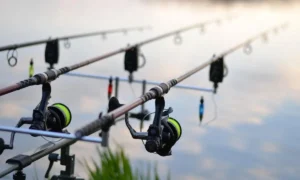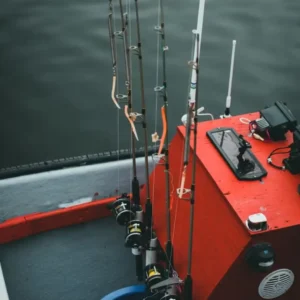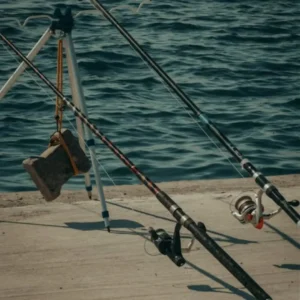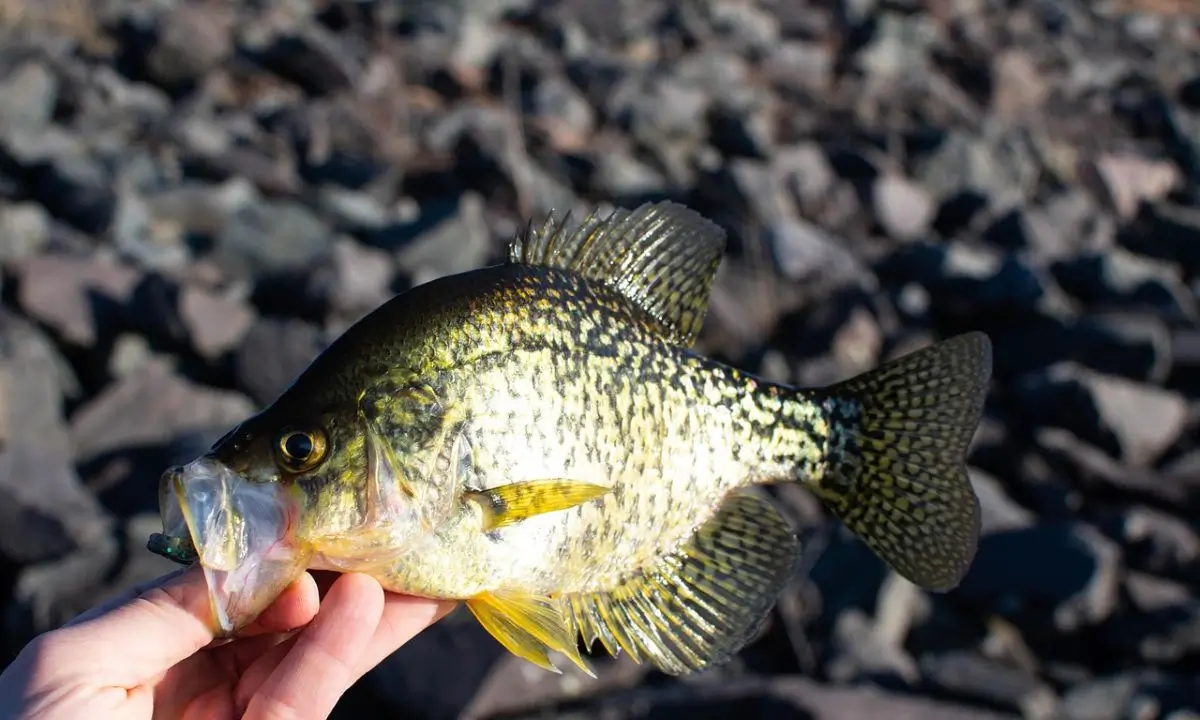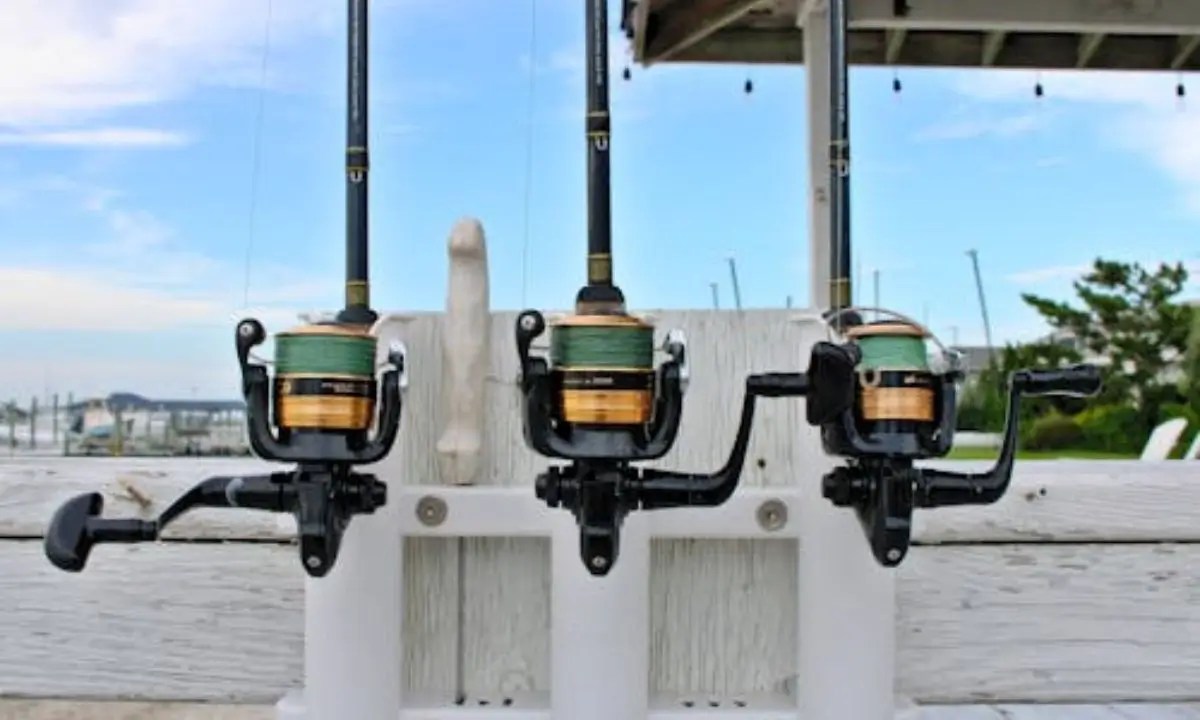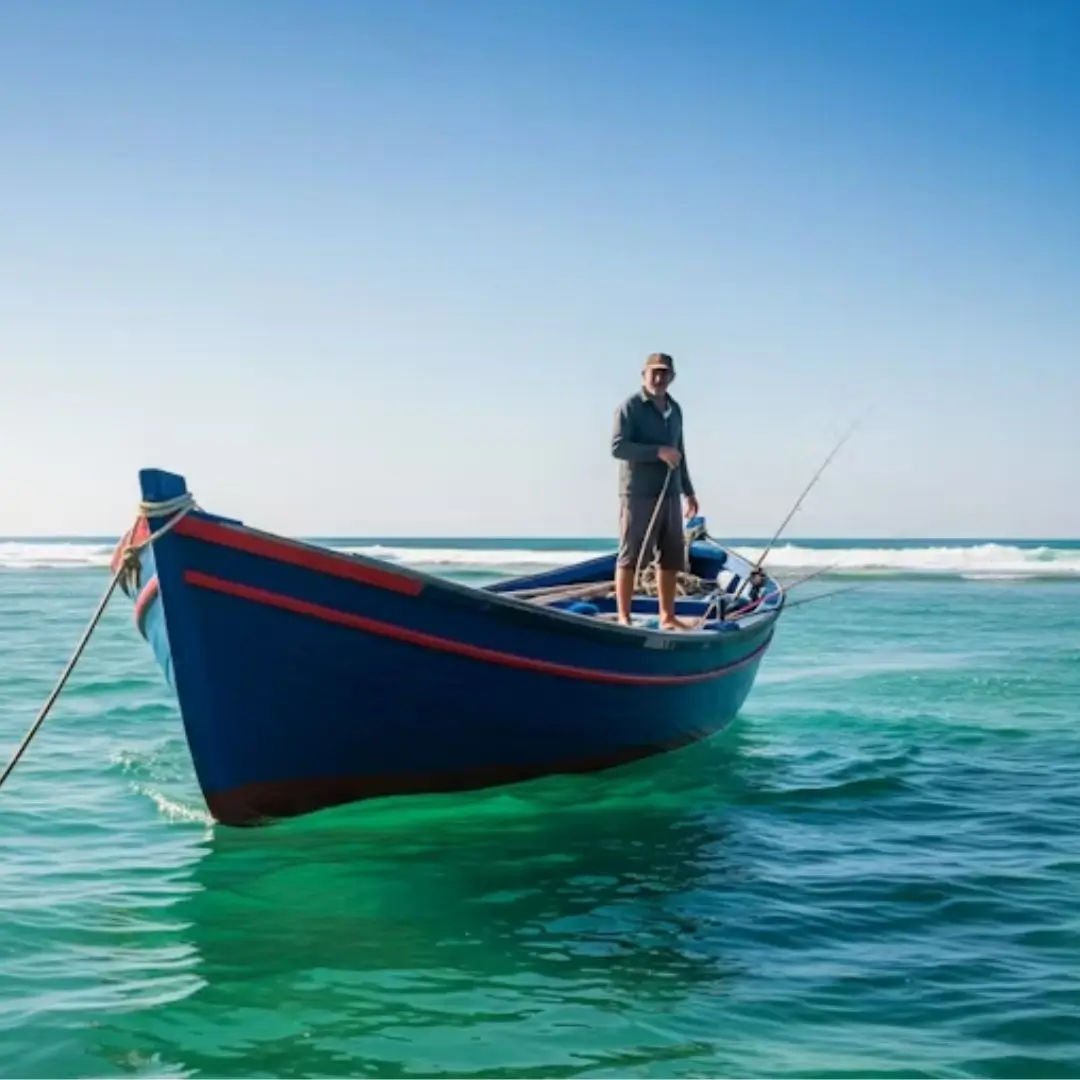Homemade Fishing Pole Holder – A Smart Storage Hack for Anglers in 2025
Storing fishing rods the right way prevents damage, rust, and bending. Use rod racks, sleeves, and dry storage areas to protect your gear. Proper fishing rod storage increases durability and keeps your rods ready for every trip.
🔹 Introduction
Storing fishing rods properly is one of the most important steps to protect your fishing gear and make it last longer. Many anglers invest in high-quality rods but lose performance simply because of poor storage habits. Whether you keep them at home, in the garage, or while traveling, the right fishing rod storage method prevents bending, rust, and unnecessary damage. Using a fishing rod rack, protective sleeves, and basic fishing rod maintenance can make a huge difference.
In this guide, we will cover the best tips for storing fishing rods safely in 2025. From avoiding common mistakes to choosing the right storage tools, you will learn everything you need to keep your rods in perfect condition and always ready for your next fishing adventure. more details Fishing Rod and Reel Combos
Why You Need a Homemade Fishing Pole Holder
A store-bought rod rack can be expensive, bulky, or poorly suited to your space. Building your own fishing rod rack allows you to customize it for your garage wall, attach it to your car roof, or create a dedicated storage space in your shed for the long haul. These solutions help prevent storing fishing rods bent, tangled, or damaged.
Benefits:
- Prevents rod damage & hook snags
- Perfect for storing fishing rods long term
- Budget-friendly and customizable
- Saves space on garage walls or ceilings
Common Mistakes Anglers Make in Rod Storage
Many anglers unknowingly damage their rods because of small storage mistakes. The most common issue is keeping rods wet after fishing. Moisture creates rust on guides and weakens the rod blank, which shortens the rod’s lifespan. Another mistake is exposing rods to direct sunlight. Continuous UV rays can fade the finish and make the rod brittle over time. Some anglers also use a poor-quality fishing rod rack or simply lean rods against walls. This can bend the tips, loosen the guides, and cause unnecessary stress on the rod
Storing rods in garages or cars without protection is another problem. Extreme heat, cold, or humidity can warp the rod and damage the epoxy. Many anglers also forget basic fishing rod maintenance before storage, such as cleaning and drying the rod properly.
Avoiding these mistakes is the first step toward protecting your gear. By learning proper fishing rod storage methods, you can keep your rods safe, maintain their strength, and enjoy smooth performance on every trip.
Best Indoor Storage Tips
Indoor storage is the safest and most reliable way to protect your fishing rods. A simple change in how you organize them can prevent years of damage. The best method is to use a fishing rod rack. Vertical rod racks keep rods straight and prevent bending, while wall-mounted racks save space and keep everything organized.
Another smart option is using rod sleeves. These protective covers stop rods from getting scratched, tangled, or collecting dust when stored in a corner. If you have multiple rods, sleeves make it easier to take out the right one without damaging the others.
Temperature also matters. Keep rods in a cool, dry room and away from direct sunlight, heaters, or windows. Extreme heat or cold can weaken the blank and shorten the rod’s lifespan. For long-term indoor storage, it’s better to remove the reel. This reduces pressure on the reel seat and keeps the rod light.
Finally, don’t forget basic fishing rod maintenance before storing indoors. Clean the rod with a soft cloth, dry it completely, and check the guides for rust. A little care before storage ensures your rods stay in excellent condition and ready for your next fishing trip.
Best Places to Use Your DIY Fishing Pole Holder
1. Fishing Rod Holders for Garage Walls
Using vertical wall space is ideal for storing fishing rods in garage settings. You can:
- Install a rod rack made of PVC or wood
- Add a fishing rod hook keeper to avoid line tangles
- Use wall anchors for extra safety
💡 Tip: Try a magnetic strip to hold small metal parts or hooks nearby!
2. Storing Fishing Rods in Car or Truck
Before setting off on a fishing trip, it’s important to ensure your gear is stored properly in your vehicle. Think about the following:
- Use overhead rod racks to keep your fishing rods safely stored inside your vehicle.
- Velcro straps or bungee cord systems
- DIY rod roof mounts for storing fishing rods in truck
3. Ceiling Mounts for Saving Garage Space
For those with limited space, storing fishing rods on the ceiling is a space-saving hack. PVC pipe racks or wooden brackets can keep rods secure and out of the way..
Seasonal Storage
Fishing rods need different care depending on the season, because weather changes can directly affect their strength and performance. In winter, the biggest risk is moisture. Cold and damp conditions create rust on guides and weaken the rod blank. Always clean your rods, dry them fully, and use rod sleeves or protective cases before storing them. Keep rods away from freezing areas like basements or outdoor sheds without insulation.
In summer, heat becomes the main problem. High temperatures can soften epoxy, loosen guides, and even warp the blank. Never leave your rods in hot cars or garages. Instead, store them in a cool, shaded area and use a fishing rod rack to keep them straight.
During the rainy season or in humid regions like Florida, excess moisture can quickly damage your gear. Use silica gel packs or dehumidifiers in your storage space to control humidity and prevent mold.
By adjusting your fishing rod storage methods according to the season, you protect your gear all year long. This simple habit extends the lifespan of your rods and ensures they are always ready when fishing season begins again.
Travel & Long-Term Storage
Fishing trips often require carrying rods from one place to another, and without proper protection, they can get damaged easily. The safest option for travel is using rod tubes or hard cases. These keep rods straight, prevent bending, and protect them from impact during flights or long car rides. For multi-piece rods, disassemble each section and place them in rod sleeves before packing. This avoids scratches and makes transportation easier.
When it comes to long-term storage, extra care is needed. Always clean and dry your rods before storing them for months. Remove reels to reduce stress on the reel seat and store them separately in reel cases. Keep rods in a fishing rod rack or wall-mounted holder so they don’t bend under their own weight. Avoid damp basements or hot garages, as extreme temperatures can weaken rod materials.
Check your rods every few weeks if they’re in long-term storage. A quick inspection helps you spot early signs of rust, mold, or warping. With these travel and long-term storage tips, your rods will stay safe and ready for the next fishing season.
Maintenance Before Storage
Proper maintenance before storing fishing rods is essential to keep them in top condition. Start by cleaning the rod with warm water and mild soap to remove dirt, salt, or fish residue. Saltwater in particular can quickly corrode guides and reel seats if not cleaned properly.
Next, dry the rod completely. Never store a wet rod, as moisture can cause rust and weaken the blank over time. Inspect the guides and reel seat for any cracks, rust, or loose parts. Fixing small issues before storage prevents bigger problems later.
For long-term storage, it’s recommended to remove the reel. This reduces pressure on the rod blank and makes handling easier. If you keep the reel attached, loosen the line tension to prevent stress on the rod.
Finally, consider adding rod sleeves or protective covers. These protect your rods from scratches, dust, and tangling with other rods. Performing this simple maintenance routine before storage ensures your rods stay safe, durable, and ready for your next fishing adventure. in details Top 10 Fishing Rod tips
🧰 Best DIY Fishing Rod Storage Ideas for Your Garage
A clutter-free garage is every angler’s dream. Below are some of the best DIY fishing rod rack and fish rod holder for garage ideas that are easy to build, budget-friendly, and effective for storing fishing rods long term.
🧱 1. Wall-Mounted Fishing Rod Rack
Wall-mounted rod racks are one of the most efficient ways to store fishing rods in garage.
What You’ll Need:
- Wood planks or PVC pipes
- A drill and screws
- Measuring tape
- Foam padding or clips
Steps:
- Measure the length of your fishing rod and plan the spacing on the wall to match
- Secure the rod handles by either drilling holes or mounting clips in place
- Add foam for a snug fit and avoid damage.
✅ Ideal for horizontal rod storage and for keeping your gear elevated off the ground.
🧺 2. Ceiling-Mounted Rod Holder
This method saves floor space and is great for storing fishing rods on ceiling.
Benefits:
- Keeps rods safe and dry
- Utilizes overhead garage space
- Looks professional and clean
Bonus Tip: Use bungee cords or Velcro straps to hold rods firmly in place.
🚗 3. Fishing Rod Storage in Car or Truck
Travel often with your gear? Let’s see how to store fishing rods in car and truck without tangling or damage:
- Use a fishing rod case for protection during travel.
- Install roof rod holders or extendable interior straps.
- Using PVC tubes or foam padding helps stop hooks from catching on your car’s interior
✅ Whether it’s storing fishing rods in truck beds or hatchbacks, secure them with tension rods or magnetic mounts.
🛠️ 4. DIY Fishing Pole Holder from PVC Pipes
Want a quick and affordable fix? Try this homemade fishing pole holder:
Materials:
- 1.5-inch PVC pipes
- Pipe cutter
- Zip ties or clamps
- Spray paint (optional)
Instructions:
- Cut the pipes to 12-14 inch pieces.
- Attach vertically to a wooden frame or toolbox side.
- Customize the design for a garage, boat, or car.
🧡 Ideal for beginner DIYers and works both indoors and outdoors.
💡 Pro Tip: Use a Rod Hook Keeper
A small but useful add-on, a fishing rod hook keeper prevents tangled lines during storage. It also protects your fingers and gear from accidental hook snags.
Best Tools & Products for Rod Storage
Using the right tools and products makes storing fishing rods much easier and protects them from damage. One of the most important items is a fishing rod rack. Vertical or wall-mounted racks keep rods straight, prevent bending, and save space in your home, garage, or shed.
Rod tubes and hard cases are excellent for travel or garage storage. They shield rods from accidental bumps, moisture, and temperature changes. Multi-piece rods can be disassembled and stored in separate rod sleeves inside the tubes for extra protection.
For everyday protection, simple rod sleeves or covers prevent scratches, dust, and tangling with other rods. These are especially useful if you own several rods or need to move them frequently.
Moisture control products like silica gel packs or small dehumidifiers are essential in humid areas. They keep guides and reels rust-free, especially in garages or sheds.
Finally, for anglers with multiple rods, wall-mounted or ceiling-mounted holders are great solutions. They keep rods off the floor, organized, and safe from accidental damage. Investing in these tools not only extends the life of your rods but also makes your fishing setup clean, organized, and always ready for your next adventure. details Fishing Line Last
🧼 How to Store Fishing Rods Long-Term: Essential Tips
When storing your fishing rods for long periods—such as during the off-season or winter months—you need to take extra care. Here’s how:
✅ Clean and Dry Your Rods
Before storing fishing rods long term, always:
- Clean them by gently wiping with a damp cloth to get rid of salt and grime.
- Dry them completely to prevent mold and corrosion.
- Take off reels, lures, and fishing lines to ease tension and prevent damage.
✅ Use a Fishing Rod Case or PVC Tube
A fishing rod case or a homemade PVC pipe holder provides extra protection for your gear. This prevents your rods from bending or getting scratched in storage.
✅ Store Horizontally When Possible
Keeping fishing rods stored horizontally helps spread their weight evenly, preventing bending as time passes. Using racks mounted on walls or holders fixed to the ceiling works best for this. details Fishing Rod Far
🚗 How to Store Fishing Rods in Cars, Trucks, and Caravans
If you’re storing fishing gear while traveling or camping, use these hacks:
🚙 In Cars:
- Use bungee cords to secure rods along the ceiling or side.
- A hook keeper on your fishing rod helps keep it neatly in place and minimizes the chances of tangling.
🚚 In Trucks:
- Use a rod rack mounted inside the truck bed or behind the seats.
- Consider installing DIY fishing pole holders on truck caps for long trips.
🚐 In Caravans:
- Use wall-mounted holders or Velcro straps to avoid rods rolling around.
- Always secure rods before moving to prevent breakage.
☀️ Can You Store Fishing Rods Outside?
Storing fishing rods outside is not ideal due to sunlight, humidity, and temperature changes. But if you must:
- Use waterproof rod cases.
- Avoid direct sunlight.
- Elevate rods off the ground to avoid moisture damage.
Conclusion
Properly storing fishing rods is essential to keep them safe, durable, and ready for every fishing trip. By avoiding common mistakes, using indoor or outdoor storage methods, maintaining rods before storage, and investing in the right tools like rod racks, sleeves, and protective cases, you can extend the life of your fishing gear. Seasonal adjustments and travel precautions also play a big role in protecting your rods. Follow these tips consistently, and your rods will perform better for years to come. Share your own fishing rod storage experiences in the comments below—we’d love to hear your tips!
👉 Ready to take your rod storage to the next level? Start with a simple DIY project or upgrade your garage storage today—your fishing rods will thank you!
✍️ Written by Jihad – Professional Fisherman
Website: profishingbyjihad.com
What is the best way to store fishing rods?
Use a vertical rod rack or wall-mounted holder to keep rods straight, organized, and protected from bending or scratches.
How should I protect rods while traveling?
Use rod tubes or hard cases. Disassemble multi-piece rods and place them in rod sleeves to prevent tangling or damage.
What are common mistakes in rod storage?
Avoid storing wet rods, leaving rods in direct sunlight, or using poor-quality racks. These can cause rust, warping, or broken tips.
What tools are best for fishing rod storage?
Invest in rod racks, rod tubes, protective sleeves, and wall-mounted holders. These keep rods safe, organized, and ready for your next fishing trip.
How does temperature affect rod storage?
Extreme heat or cold can warp the rod or weaken epoxy. Store rods in a cool, dry, and insulated area to maintain their strength.
Should I remove reels before storing rods?
Yes, remove reels to reduce stress on the rod blank and store them separately in reel cases for long-term protection.
Should I loosen the fishing line during storage?
Always loosen line tension. Tight lines put stress on guides and the rod blank, which can damage your fishing gear over time. Travel & Long-Term Storage Best Tools & Products for Rod Storage




